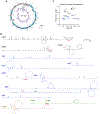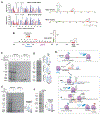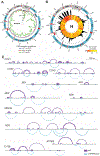The human mitochondrial mRNA structurome reveals mechanisms of gene expression
- PMID: 39024447
- PMCID: PMC11510358
- DOI: 10.1126/science.adm9238
The human mitochondrial mRNA structurome reveals mechanisms of gene expression
Abstract
The human mitochondrial genome encodes crucial oxidative phosphorylation system proteins, pivotal for aerobic energy transduction. They are translated from nine monocistronic and two bicistronic transcripts whose native structures remain unexplored, posing a gap in understanding mitochondrial gene expression. In this work, we devised the mitochondrial dimethyl sulfate mutational profiling with sequencing (mitoDMS-MaPseq) method and applied detection of RNA folding ensembles using expectation-maximization (DREEM) clustering to unravel the native mitochondrial messenger RNA (mt-mRNA) structurome in wild-type (WT) and leucine-rich pentatricopeptide repeat-containing protein (LRPPRC)-deficient cells. Our findings elucidate LRPPRC's role as a holdase contributing to maintaining mt-mRNA folding and efficient translation. mt-mRNA structural insights in WT mitochondria, coupled with metabolic labeling, unveil potential mRNA-programmed translational pausing and a distinct programmed ribosomal frameshifting mechanism. Our data define a critical layer of mitochondrial gene expression regulation. These mt-mRNA folding maps provide a reference for studying mt-mRNA structures in diverse physiological and pathological contexts.
Conflict of interest statement
Competing interests:
The authors declare no competing interests.
Figures






Update of
-
The human mitochondrial mRNA structurome reveals mechanisms of gene expression.bioRxiv [Preprint]. 2023 Nov 2:2023.10.31.564750. doi: 10.1101/2023.10.31.564750. bioRxiv. 2023. Update in: Science. 2024 Jul 19;385(6706):eadm9238. doi: 10.1126/science.adm9238. PMID: 37961485 Free PMC article. Updated. Preprint.
References
-
- Rackham O, Filipovska A, Organization and expression of the mammalian mitochondrial genome. Nat. Rev. Genet 23, 606–623 (2022). - PubMed
-
- Al-Faresi RAZ, Lightowlers RN, Chrzanowska-Lightowlers ZMA, Mammalian mitochondrial translation - revealing consequences of divergent evolution. Biochem. Soc. Trans 47, 1429–1436 (2019). - PubMed
-
- Gustafsson CM, Falkenberg M, Larsson NG, Maintenance and Expression of Mammalian Mitochondrial DNA. Annu. Rev. Biochem 85, 133–160 (2016). - PubMed
MeSH terms
Substances
Grants and funding
LinkOut - more resources
Full Text Sources
Molecular Biology Databases
Miscellaneous

